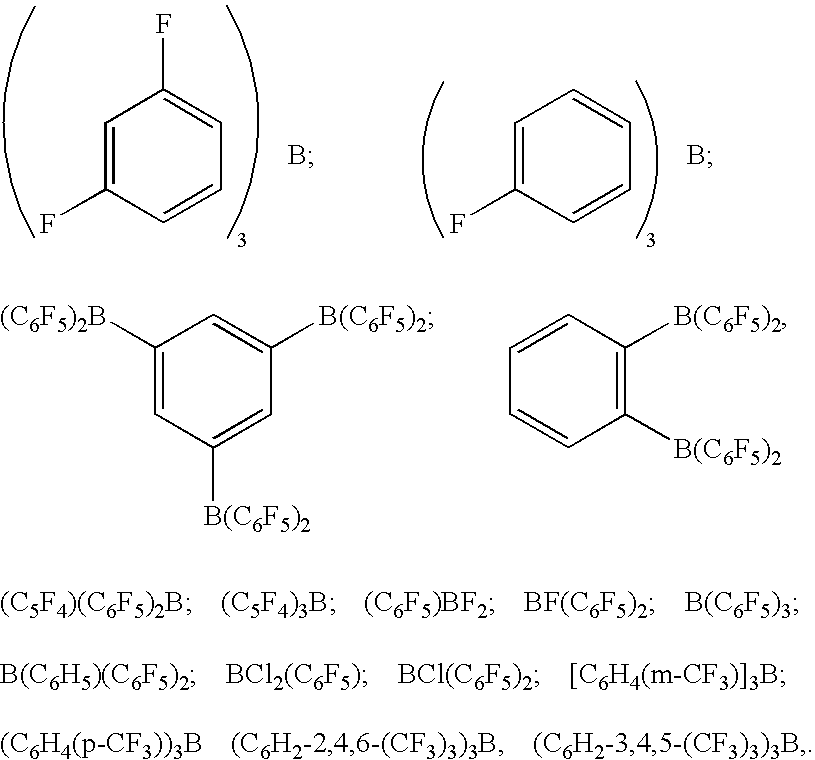Disproportionation of hydridosiloxanes and crosslinked polysiloxane network derived therefrom
a technology of hydridosiloxanes and crosslinked polysiloxane, which is applied in the field of disproportionation of hydridosiloxanes to produce a product mixture, can solve the problems of high reactive hydrogen, dangerous by-product of this process, and high risk of synthesis reaction, so as to achieve safe and convenient
- Summary
- Abstract
- Description
- Claims
- Application Information
AI Technical Summary
Benefits of technology
Problems solved by technology
Method used
Image
Examples
example 1
[0039] In a 20 milliliter (ml) glass scintillation vial equipped with a magnetic stir bar, 5 grams (g) (0.024 moles) of D4H was mixed with 0.0025 g (4.88×10−6 moles) of tris(pentafluorophenyl)borate. The vial was sealed with a plastic cap and the reaction mixture was magnetically stirred at room temperature. The reaction mixture increased in viscosity rapidly and then solidified after 5 minutes to form an elastic gel. Bubbles of gas started to form inside the gel in the next 5 minutes which led to a pressure buildup in the vial. In next few minutes the elastic gel turned into solid and brittle foam. At this point the rate of the gas formation was observed to have significantly decreased. GC / MS analysis of the released gas showed the formation of MeSiH3 and less than 1% of Me2SiH2. Solid State 29Si NMR analysis confirmed formation of MeSiO3 / 2 and MeSiH2O1 / 2 groups.
example 2
[0040] In a 20 ml glass scintillation vial equipped with a magnetic stir bar, 5 g of a linear siloxane copolymer comprising about 50 mole % of dimethylsiloxane structural units and 50 mole % of methylhydridosiloxane structural units was mixed with 0.005 g (9.76×10−6 moles) of tris(pentafluorophenyl)borate. The vial was sealed with a plastic cap and the reaction mixture was magnetically stirred at room temperature. The reaction mixture increased in viscosity rapidly and then solidified after 5 minutes to form an elastic gel. Bubbles of gas started to form inside the gel in the next 5 minutes. In next few minutes the elastic gel turned into solid foam. At this point the rate of the gas formation was observed to have significantly decreased. GC / MS analysis of the released gas showed the formation of MeSiH3 and less than 1% of Me2SiH2.
PUM
| Property | Measurement | Unit |
|---|---|---|
| Temperature | aaaaa | aaaaa |
| Temperature | aaaaa | aaaaa |
| Fraction | aaaaa | aaaaa |
Abstract
Description
Claims
Application Information
 Login to View More
Login to View More - R&D
- Intellectual Property
- Life Sciences
- Materials
- Tech Scout
- Unparalleled Data Quality
- Higher Quality Content
- 60% Fewer Hallucinations
Browse by: Latest US Patents, China's latest patents, Technical Efficacy Thesaurus, Application Domain, Technology Topic, Popular Technical Reports.
© 2025 PatSnap. All rights reserved.Legal|Privacy policy|Modern Slavery Act Transparency Statement|Sitemap|About US| Contact US: help@patsnap.com

